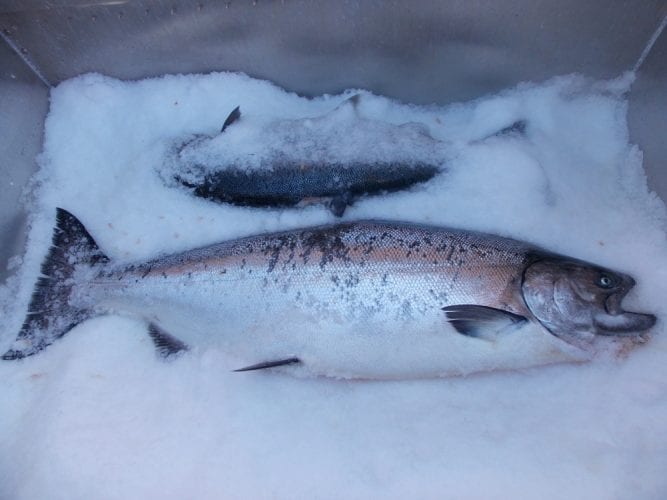Bag limits, closures and other regulations for king salmon sport fishing in Southeast Alaska this year will look similar to last year. That’s after Alaska’s Board of Fisheries this month approved a new regional management plan for chinook sport fishing. Although the plan won limited support from both sport and commercial fishing advocates, it’s viewed as only a stop gap until the board meets again on Southeast salmon issues in two years.

This king weighing just under 46 pounds won Madison Whitethorn second place in Petersburg’s 2015 salmon derby. (KFSK file photo)
The Alaska Department of Fish and Game proposed the management plan to align with the new terms of the Pacific Salmon Treaty, which was renegotiated last year. The plan connects harvest limits for sport fishing to the commercial troll fleet’s winter catch rates. It’s a seven-tiered system that ratchets down bag and annual limits depending on the success of winter trolling. When the commercial harvest has been bad, like it’s been this winter, sport fishing for kings can be cut back, or even closed.
Sport fish stakeholders came to the board’s January meeting in Anchorage opposing the plan and offering alternatives. Larry Edfelt of the Territorial Sportsmen, a Juneau-based hunting and fishing organization urged the board to focus conservation measures on anglers from out-of-state.
“So the resident fishermen in Southeast are contributing to king salmon conservation to a far greater degree than the outside fishermen are,” Edfelt said. “Sitka and Prince of Wales is where most of the non-resident catch comes from. And like I mentioned in my testimony, two thirds of the allocation is taken by non-residents. So we think the burden of conservation should be shared a little more. There’s no spring closures on the outside. That fishery remains open in May and June when the inside fisheries are closed.”
Last year king fishing in springtime was closed throughout the inside waters and that’s the case again this year. The measure is aimed at conserving stocks returning to Southeast rivers, the Chilkat, Taku, Stikine and Unuk. And that will continue under the new management plan.
Charter operators thought the plan was rushed. Forrest Braden is executive director of the Southeast Alaska Guides Organization. He asked the board to wait for more input.
“We don’t expect harvest reductions to be painless,” Braden said. “We do believe that more opportunity for stakeholder weigh-in and outside-of-the-box thinking can produce a better product and help alleviate negative impacts to all users of the resource.”
Representatives from the charter fleet and resident anglers were joined at the meeting by advocates for the commercial troll fleet. The commercial fleet is also facing continuing fishery closures and more harvest reductions under the new terms of the Pacific Salmon Treaty.
Amy Daugherty, executive director of the Alaska Trollers Association was supportive of the sport management’s plan reliance on commercial catch rates and a preference for resident anglers. But she also wanted accountability to keep catches under limits.
“This is getting to be a smaller and smaller box that we’re in and we encourage accountability between sectors,” Daugherty said. “We are willing to be responsible for our allocation and we hope that the other parties involved move forward in that direction.”
Board members and stake holders hammered out a compromise in a subcommittee. The amended proposal creates a resident fishing preference in times of low numbers. Stakeholders agreed to allow a liberalized two-fish bag limit for resident anglers on inside waters once they reopen later in the summer. Added language also gives the department the option to close non-resident sport fishing if the region’s sport catch is expected to exceed its allocation. Out-of-state visitors will also have annual limits that get tighter later in the year.
Sitka charter boat and lodge operator Seth Bone supported early fishing opportunity for charter businesses.
“The reason that the plan contemplates better limits in the early part of the season is because there’s no alternative salmon species,” Bone said. “So it’s very important to have a marketable trip to sell in May and June by having more opportunity there and potentially less in mid to late summer.”
Representatives for both sport and commercial fleets voiced support for the amended language but called the new plan a stop gap until the Board meets again on Southeast finfish issues in two years.
Board member Robert Ruffner of Soldotna was willing to support the complicated management plan.
“Often when we kind of work these things out there’s a couple of board members who are able to work on things and the rest of us can stand by and watch what comes out and this is pretty complicated to wrap your head and trust that the stakeholders that showed up to work on this are in agreement. So I’m putting quite a bit of faith in the members that worked on this to come up with this deal,” Ruffner said.
The amended proposal passed unanimously.
The sport catch of king salmon in Southeast last year was just over 21-thousand fish, well below the allocation. This season, working on the third lowest of the seven tiers of the plan, managers expect the new plan will keep the sport catch below that limit. That’s even with the liberalized bag limits for residents later in the season. But going over will be penalized. If the combined sport and commercial catch exceeds the Southeast allocation, the overage will be deducted from next year’s harvest.










